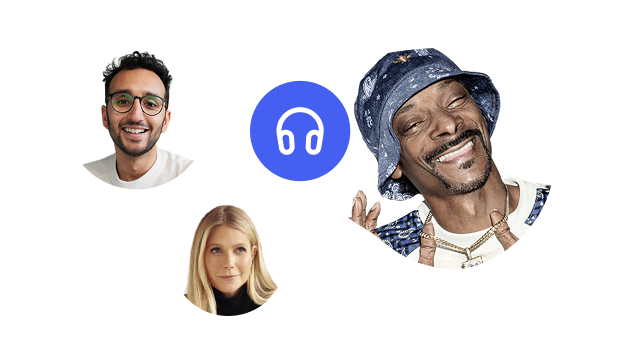Living with ADHD often means fighting an invisible tug-of-war between intention and attention. Reading long paragraphs can feel impossible, instructions blur together, and even finishing a page can take monumental effort. That’s not a lack of intelligence but rather how the ADHD brain processes information. Text to speech technology bridges that gap by turning written words into natural-sounding audio, giving people with ADHD a way to listen, focus, and actually absorb what they’re reading. Let’s explore everything you need to know about text to speech for ADHD.
What Is Text To Speech?
Text to speech (TTS) is an assistive technology that converts written or digital content like articles, books, PDFs, or web pages into spoken audio. With TTS, users can listen to their reading materials while multitasking, reducing screen fatigue and cognitive overload. Modern TTS tools, such as Speechify, use AI voices that sound natural and human-like, making listening both enjoyable and effective.
The Reading Struggles of ADHD
For individuals with ADHD, reading can feel like a constant uphill battle. Here’s just a brief breakdown of what it’s like to read with ADHD.
Short Attention Span and Wandering Focus
For many people with ADHD, reading can feel like trying to tune into a radio station that keeps fading in and out. The intention to focus is there, but concentration slips away within moments. Paragraphs that start out clear soon turn into a blur of disconnected words as the mind begins to wander toward unrelated thoughts or sensory distractions. This short attention span makes it incredibly difficult to finish books, assignments, or even short articles without frequent re-reading. The effort to “force” focus can leave ADHD readers mentally exhausted, frustrated, and sometimes feeling defeated, even when they genuinely want to learn or enjoy the content in front of them.
Difficulty Starting or Finishing Tasks
Executive dysfunction is one of the hallmark struggles of ADHD. Even when motivation is high, initiating a task can feel like staring at a mountain from the base. The first step feels too heavy to take. Reading, especially dense or unfamiliar material, can seem like an endless commitment, leading to procrastination or avoidance. For students, this might mean putting off reading assignments until the last minute; for adults, it can mean a growing pile of unread emails, reports, or books. This sense of paralysis isn’t laziness, it’s a neurological difficulty in activating the brain’s “start button,” which can lead to shame and frustration when others don’t understand.
Visual Fatigue and Information Overload
Sitting still to read for long periods can be overwhelming for people with ADHD. Their brains are wired for movement, change, and stimulation, not for hours of silent, static focus. Over time, the effort to constantly refocus the eyes and mind on words can cause visual fatigue, leading to headaches, mental fog, and a drop in comprehension. The sensory overload of long reading sessions often triggers avoidance; what begins as enthusiasm to learn or study turns into frustration and burnout. For many ADHD readers, this cycle of exhaustion and avoidance makes consistent reading feel impossible.
Low Reading Comprehension and Retention
Even when individuals with ADHD manage to focus long enough to read, retention is often another challenge. Attention lapses can cause gaps in understanding, and by the end of a page, it’s common to realize that very little of the information actually stuck. This can be discouraging and time-consuming, as readers find themselves rereading the same material over and over just to grasp the meaning. Poor comprehension not only affects academic and professional performance but also chips away at confidence, reinforcing the false belief that “I’m just bad at reading.”
Disrupted Routines and Inconsistent Study Habits
ADHD often interferes with time management, planning, and consistency, which is all essential for maintaining steady reading or study habits. Days rarely go as planned, and the mental energy required to sit down and focus can fluctuate wildly. Even when motivation strikes, distractions or shifting priorities can derail good intentions. This inconsistency can make it difficult to complete long-term reading goals, like finishing a textbook, keeping up with work materials, or reading for personal growth. Over time, the frustration of “falling behind” can turn into avoidance altogether.
How Text to Speech Addresses ADHD
Text to speech empowers individuals with ADHD to process information in a way that aligns with how their brains work best. Here’s how.
How Text To Speech Enhances Focus
Text to speech transforms the entire reading experience by converting text into spoken audio. This shift from visual to auditory input allows ADHD users to bypass one of their biggest hurdles — sustaining visual attention. Listening engages the brain differently, helping users remain immersed in the material without the strain of tracking words on a page.
How Text To Speech Supports Executive Function
Text to speech offers a powerful solution by eliminating that intimidating first step. Instead of facing a static wall of text, users can simply click a button and hear the words come alive. The instant feedback of a voice reading aloud can spark engagement and make starting much easier. Once the audio begins, momentum builds naturally, and finishing a chapter or report feels achievable.
How Text To Speech Reduces Visual Fatigue
Text to speech relieves that burden by transforming reading into an experience that works with the ADHD brain instead of against it. By shifting the input to the auditory channel, it gives tired eyes and overstimulated minds a break. Listening allows the brain to stay engaged without the need for constant visual effort, and the ability to multitask—like walking, exercising, or organizing—channels restlessness into productive energy. This kind of movement-based learning helps ADHD users process information more effectively and prevents burnout.
How Text To Speech Improves Comprehension
Text to speech changes that dynamic by presenting information in a way that aligns with how many ADHD brains process best—through sound. Listening activates auditory processing areas in the brain, helping users connect ideas more fluidly and remember them longer. When combined with features like highlighted text tracking, as found in tools like Speechify, TTS engages both visual and auditory learning simultaneously. This dual input reinforces understanding and memory, allowing users to follow complex material without losing their place.
How Text To Speech Assists Routines
Text to speech gives ADHD users the flexibility they need to succeed on their own terms. Because listening doesn’t require being glued to a screen, it can be seamlessly integrated into everyday life, while commuting, cooking, exercising, or winding down before bed. This flexibility helps transform downtime into learning time and turns inconsistent schedules into opportunities for progress. Users can create a routine around listening instead of reading, allowing information intake to fit naturally into the rhythm of their day.
How Speechify Helps ADHD
Speechify is more than just a text to speech app—it’s a full AI reading assistant designed with ADHD users in mind. Its text highlighting feature visually tracks each word as it’s read aloud, helping users stay engaged and follow along without losing focus. The lifelike AI voices make listening feel natural and dynamic, keeping the ADHD brain stimulated and attentive through human-like tone and pacing. Beyond reading aloud, Speechify’s AI tools—including AI Chat, AI Summaries, and AI Quizzes—take comprehension and retention even further. Users can quickly review the main ideas of what they’ve read, ask follow-up questions for clarification, and test their understanding with interactive quizzes. Together, these features transform reading from a draining task into an active, multisensory experience that helps ADHD users focus better, learn faster, and actually enjoy the process of reading again.
FAQ
How does text to speech help people with ADHD focus better?
Text to speech platforms like Speechify convert written text into engaging, natural-sounding audio, allowing people with ADHD to listen and maintain focus without visual strain.
Can text to speech improve reading comprehension for ADHD users?
Yes, text to speech apps like Speechify combine lifelike AI voices and synchronized text highlighting to help ADHD users follow along and retain more information while listening.
Is text to speech effective for students with ADHD?
Absolutely, text to speech platforms, such as Speechify, help students with ADHD complete assignments more efficiently by turning textbooks, PDFs, and notes into easy-to-listen audio lessons.
Does Speechify support multitasking for people with ADHD?
Yes, Speechify enables ADHD users to listen while doing other activities like exercising or organizing, turning everyday moments into productive learning time.
Why is Speechify considered one of the best text to speech tools for ADHD?
Speechify offers realistic text to speech AI voices, personalized playback controls, synchronized text highlighting and smart features like AI Chat and Summaries, making it perfect to improve learning and focus for ADHD students.





